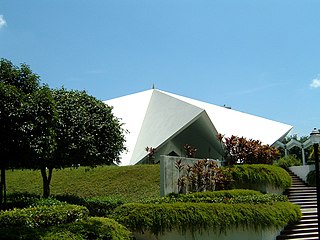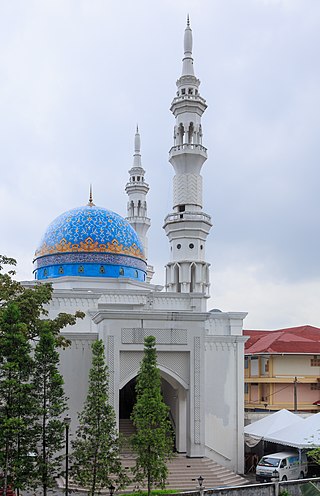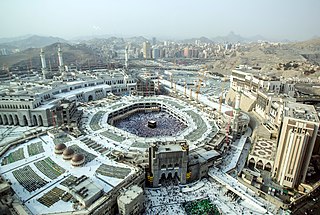
Abū Ḥāmid Muḥammad ibn Muḥammad al-Ṭūsiyy al-Ghazali, known commonly as Al-Ghazali, known in Medieval Europe by the Latinized Algazelus or Algazel, was a Persian Sunni Muslim polymath. He is known as one of the most prominent and influential jurisconsults, legal theoreticians, muftis, philosophers, theologians, logicians and mystics in Islamic history.

The Al-Azhar University is a public university in Cairo, Egypt. Associated with Al-Azhar Al-Sharif in Islamic Cairo, it is Egypt's oldest degree-granting university and is known as one of the most prestigious universities for Islamic learning. In addition to higher education, Al-Azhar oversees a national network of schools with approximately two million students. As of 1996, over 4,000 teaching institutes in Egypt were affiliated with the university.

The National Mosque of Malaysia is a mosque in Kuala Lumpur, Malaysia. It has a capacity for 15,000 people and is situated among 13 acres (53,000 m2) of gardens. Its key features are a 73-metre-high (240 ft) minaret and a 16-pointed star concrete main roof. The umbrella, synonymous with the tropics, is featured conspicuously – the main roof is reminiscent of an open umbrella, the minaret's cap a folded one. The folded plates of the concrete main roof are a creative solution to achieving the larger spans required in the main gathering hall. Reflecting pools and fountains are spread throughout the compound. Completed in 1965, the mosque is a bold and modern approach in reinforced concrete, symbolic of the aspirations of a then newly independent nation.

Timothy John Winter, also known as Abdal Hakim Murad, is an English academic, theologian and Islamic scholar who is a proponent of Islamic neo-traditionalism. His work includes publications on Islamic theology, modernity, and Anglo-Muslim relations, and he has translated several Islamic texts.
Islamic religious leaders have traditionally been people who, as part of the clerisy, mosque, or government, performed a prominent role within their community or nation. However, in the modern contexts of Muslim minorities in non-Muslim countries as well as secularised Muslim states like Turkey, and Bangladesh, the religious leadership may take a variety of non-formal shapes.

The Makam Pahlawan is the burial ground of several Malaysian leaders and politicians. It is located near the Malaysian national mosque, Masjid Negara, in the national capital, Kuala Lumpur. Construction of the mausoleum began in 1963 in conjunction with the construction of Masjid Negara, and was completed in 1965.

The Sultan Ahmad Shah Mosque is Pahang's state mosque. It is located in Kuantan, Pahang, Malaysia.
The Saidina Abu Bakar As Siddiq Mosque (MSABA) is a prominent mosque in Bangsar, Kuala Lumpur, Malaysia. The mosque was named after Muhammad's successor (Caliph) Abu Bakr.

Gerik is a mukim and the district capital of Hulu Perak District, Perak, Malaysia. The town is also known as Rest Town due to its strategic location next to East-West Highway Federal Route 4, the main route linking Kedah, Penang and Kelantan.

Sungai Siput (U) (Malay for 'snail river', Jawi: سوڠاي سيڤوت; Tamil: சுங்கை சீப்புட்; Chinese: 和豐市/和丰市) is a town and mukim in Kuala Kangsar District, Perak, Malaysia, covering 155.141 hectares, 61.5% of the total area of Kuala Kangsar. Sungai Siput falls under the management of the Kuala Kangsar Municipal Council.
Menjalara is a major township in Kuala Lumpur, Malaysia. It is located between Kepong and Sri Damansara. Menjalara is situated adjacent to Bukit Maluri. It was named after Paduka Seri Cik Menjalara, the mother of the first Prime Minister of Malaysia, Tunku Abdul Rahman Putra Al-Haj. It was called as Edinburgh Estate before its establishment in 1980s.

The Al-Bukhari Foundation Mosque is a mosque in Kuala Lumpur, Malaysia. It is adjacent to the Victoria Institution and opposite the Jalan Hang Tuah fire station and SP9 MR4 Hang Tuah LRT station.
Dr. Lo' Lo' binti Mohd Ghazali was a Malaysian politician. She served as the Member of Parliament for the Titiwangsa constituency in Kuala Lumpur, Malaysia from 2008 until her death in 2011. Lo' Lo' was a career physician who was elected to the central committee of the Pan-Malaysian Islamic Party (PAS) in 2001.

Batu Caves is a mukim and town in Gombak District, Selangor, Malaysia. Named after the limestone caves and Hindu shrine Batu Caves, the town is experiencing an increase in residences due to a housing boom in the center of the city.

Masjid al-Haram, also known as the Sacred Mosque or the Great Mosque of Mecca, is considered to be the most significant mosque in Islam. It encloses the vicinity of the Kaaba in Mecca, in the Mecca Province of Saudi Arabia. It is among the pilgrimage sites associated with the Hajj, which every Muslim must perform at least once in their lives if able. It is also the main site for the performance of ʿUmrah, the lesser pilgrimage that can be undertaken any time of the year. The rites of both pilgrimages include circumambulating the Kaaba within the mosque. The Great Mosque includes other important significant sites, such as the Black Stone, the Zamzam Well, Maqam Ibrahim, and the hills of Safa and Marwa.
Salih al-Ja'fari (1910–1979) was a Sufi and scholar, who lived and taught in Cairo, Egypt. He was officially appointed as a teacher at the al-Azhar Mosque in 1946 by the Grand Shaykh of the Azhar at the time, though he had been teaching there without an official appointment for more than a decade, and continued to teach there until his death in 1399 AH/1979 CE. He therefore taught there for more than forty years, thirty-three of those as an officially appointed teacher. During the last decade or two of his life, he became the Imam of the Azhar Mosque and one of its most celebrated teachers and orators. He was also a spiritual guide and the founder of the Ja'fariyya tariqa.
The Saidina Umar Al Khattab Mosque (MSUAK) is a prominent mosque in Bukit Damansara, Kuala Lumpur, Malaysia.

The Al-Rahman Mosque is a mosque in Kuala Lumpur, Malaysia. The mosque is located at University of Malaya in Jalan Pantai Baharu and was named after the first Malaysian Prime Minister, Tunku Abdul Rahman Putra Al-Haj. Today, the mosque is joint managed by University of Malaya and the Department of Federal Territory Islamic Affairs (JAWI).

Jamek Mosque, officially Sultan Abdul Samad Jamek Mosque is one of the oldest mosques in Kuala Lumpur, Malaysia. It is located at the confluence of the Klang and Gombak rivers and may be accessed via Jalan Tun Perak. The mosque was designed by British architect and soldier Arthur Benison Hubback, and built in 1909. It was the principal mosque of Kuala Lumpur until the construction of the national mosque Masjid Negara in 1965.

The Revival of the Religious Sciences is a 12th-century book written by the Muslim scholar al-Ghazali. The book was composed in Arabic by al-Ghazali on his spiritual crises that stemmed from his appointment as the head of the Nizzamiyya University in Baghdad, which led to his eventual disappearance from the Muslim world for over 10 years.

















